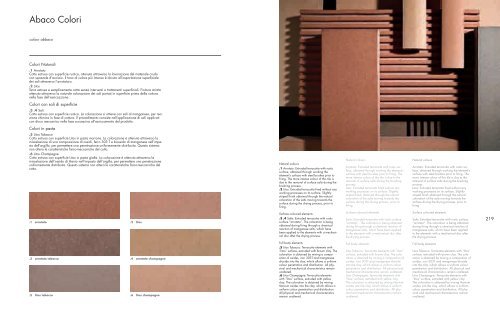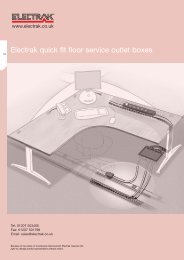by Stone & Sannini - EKA Group
by Stone & Sannini - EKA Group
by Stone & Sannini - EKA Group
You also want an ePaper? Increase the reach of your titles
YUMPU automatically turns print PDFs into web optimized ePapers that Google loves.
Abaco Colori<br />
colour abbaco<br />
Colori Naturali<br />
.1 Arrotato<br />
Cotto estruso con superficie rustica, ottenuta attraverso la lavorazione del materiale crudo<br />
con spazzole d’acciaio. Il tono di colore più intenso è dovuto all’asportazione superficiale<br />
dei sali attraverso l’arrotatura.<br />
.2 Litos<br />
Terra estrusa e semplicemente cotta senza interventi o trattamenti superficiali. Finitura striata<br />
ottenuta attraverso la naturale colorazione dei sali portati in superficie prima della cottura<br />
nella fase dell’essiccazione.<br />
Colori con sali di superficie<br />
.3 .4 Sali<br />
Cotto estruso con superficie rustica. La colorazione si ottiene con sali al manganese, per reazione<br />
chimica in fase di cottura. Il procedimento consiste nell’applicazione di sali applicati<br />
con disco meccanico nella fase successiva all’essiccamento del prodotto.<br />
Colori in pasta<br />
.5 Litos Tabacco<br />
Cotto estruso con superficie Litos in pasta marrone. La colorazione è ottenuta attraverso la<br />
miscelazione di una composizione di ossidi, ferro 303 T e biossido di manganese nell’impasto<br />
dell’argilla, per permettere una penetrazione uniformemente distribuita. Questo sistema<br />
non altera le caratteristiche fisico-meccaniche del cotto.<br />
.6 Litos Champagne<br />
Cotto estruso con superficie Litos in pasta gialla. La colorazione è ottenuta attraverso la<br />
miscelazione dell’ossido di titanio nell’impasto dell’argilla, per permettere una penetrazione<br />
uniformemente distribuita. Questo sistema non altera le caratteristiche fisico-meccaniche del<br />
cotto.<br />
.1 arrotato .2 litos<br />
.3 arrotato tabacco .4 arrotato champagne<br />
.5 litos tabacco .6 litos champagne<br />
Natural colours<br />
.1 Arrotato: Extruded terracotta with rustic<br />
surface, obtained through working the<br />
element’s surface with steel brushes prior to<br />
firing. The more intense colour of this tile is<br />
due to the removal of surface salts during the<br />
brushing process.<br />
.2 Litos: Extruded terracotta fired without any<br />
working processes on its surface. Slightly<br />
striped finish obtained through the natural<br />
coloration of the salts moving towards the<br />
surface during the drying process, prior to<br />
firing.<br />
Surface coloured elements<br />
.3 .4 Salts: Extruded terracotta with rustic<br />
surface “arrotato”. The coloration is being<br />
obtained during firing through a chemical<br />
reaction of manganese salts, which have<br />
been applied to the elements with a mechanical<br />
disc after the drying process.<br />
Full body elements<br />
.5 Litos Tobacco: Terracotta elements with<br />
“litos” surface, extruded with brown clay. The<br />
coloration is obtained <strong>by</strong> mixing a composition<br />
of oxides, iron 303T and manganese<br />
dioxide into the clay, which allows a uniform<br />
colour penetration and distribution. All physical<br />
and mechanical characteristics remain<br />
unaltered.<br />
.6 Litos Champagne: Terracotta elements<br />
with “litos” surface, extruded with yellow<br />
clay. The coloration is obtained <strong>by</strong> mixing<br />
titanium oxides into the clay, which allows a<br />
uniform colour penetration and distribution.<br />
All physical and mechanical characteristics<br />
remain unaltered.<br />
Natural colours<br />
Arrotato: Extruded terracotta with rustic surface,<br />
obtained through working the element’s<br />
surface with steel brushes prior to firing. The<br />
more intense colour of this tile is due to the<br />
removal of surface salts during the brushing<br />
process.<br />
Litos: Extruded terracotta fired without any<br />
working processes on its surface. Slightly<br />
striped finish obtained through the natural<br />
coloration of the salts moving towards the<br />
surface during the drying process, prior to<br />
firing.<br />
Surface coloured elements<br />
Salts: Extruded terracotta with rustic surface<br />
“arrotato”. The coloration is being obtained<br />
during firing through a chemical reaction of<br />
manganese salts, which have been applied<br />
to the elements with a mechanical disc after<br />
the drying process.<br />
Full body elements<br />
Litos Tobacco: Terracotta elements with “litos”<br />
surface, extruded with brown clay. The coloration<br />
is obtained <strong>by</strong> mixing a composition of<br />
oxides, iron 303T and manganese dioxide<br />
into the clay, which allows a uniform colour<br />
penetration and distribution. All physical and<br />
mechanical characteristics remain unaltered.<br />
Litos Champagne: Terracotta elements with<br />
“litos” surface, extruded with yellow clay.<br />
The coloration is obtained <strong>by</strong> mixing titanium<br />
oxides into the clay, which allows a uniform<br />
colour penetration and distribution. All physical<br />
and mechanical characteristics remain<br />
unaltered.<br />
Natural colours<br />
Arrotato: Extruded terracotta with rustic surface,<br />
obtained through working the element’s<br />
surface with steel brushes prior to firing. The<br />
more intense colour of this tile is due to the<br />
removal of surface salts during the brushing<br />
process.<br />
Litos: Extruded terracotta fired without any<br />
working processes on its surface. Slightly<br />
striped finish obtained through the natural<br />
coloration of the salts moving towards the<br />
surface during the drying process, prior to<br />
firing.<br />
Surface coloured elements<br />
Salts: Extruded terracotta with rustic surface<br />
“arrotato”. The coloration is being obtained<br />
during firing through a chemical reaction of<br />
manganese salts, which have been applied<br />
to the elements with a mechanical disc after<br />
the drying process.<br />
Full body elements<br />
Litos Tobacco: Terracotta elements with “litos”<br />
surface, extruded with brown clay. The coloration<br />
is obtained <strong>by</strong> mixing a composition of<br />
oxides, iron 303T and manganese dioxide<br />
into the clay, which allows a uniform colour<br />
penetration and distribution. All physical and<br />
mechanical characteristics remain unaltered.<br />
Litos Champagne: Terracotta elements with<br />
“litos” surface, extruded with yellow clay.<br />
The coloration is obtained <strong>by</strong> mixing titanium<br />
oxides into the clay, which allows a uniform<br />
colour penetration and distribution. All physical<br />
and mechanical characteristics remain<br />
unaltered.<br />
219





